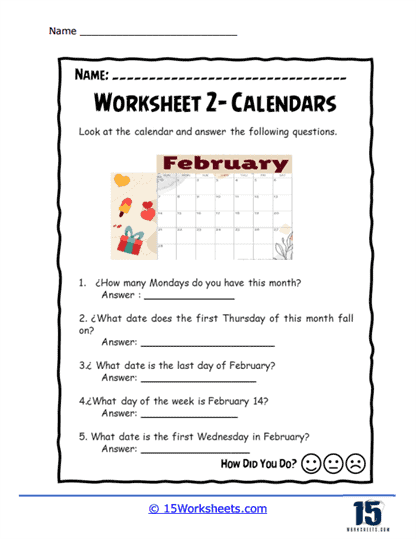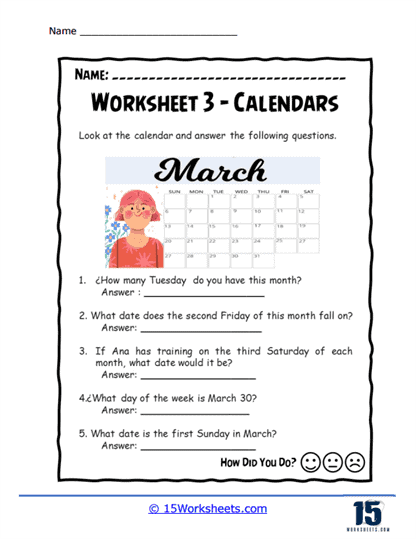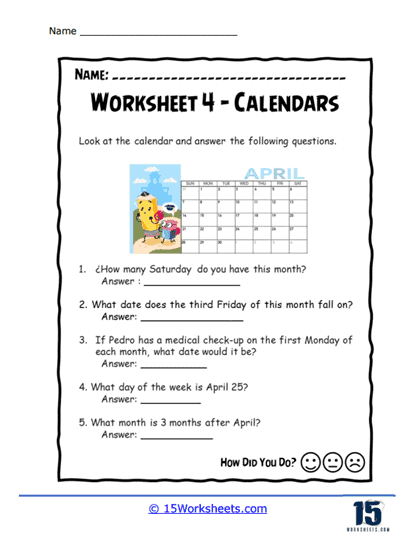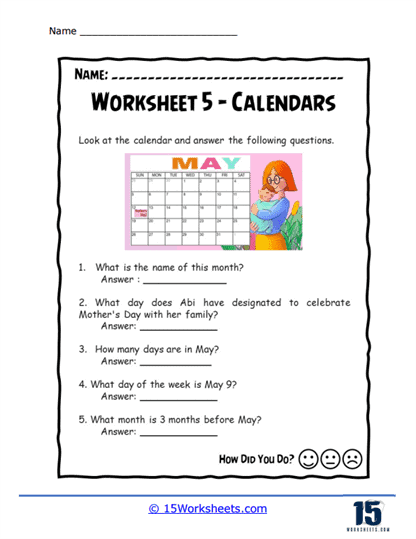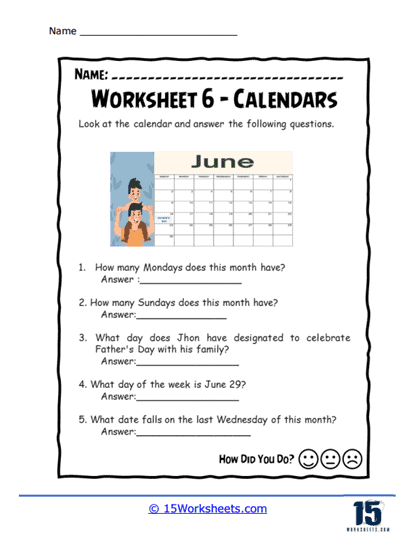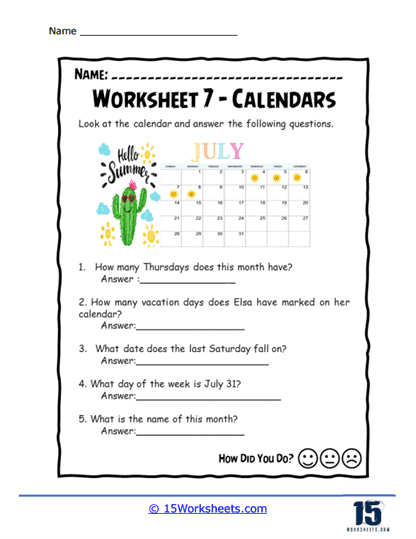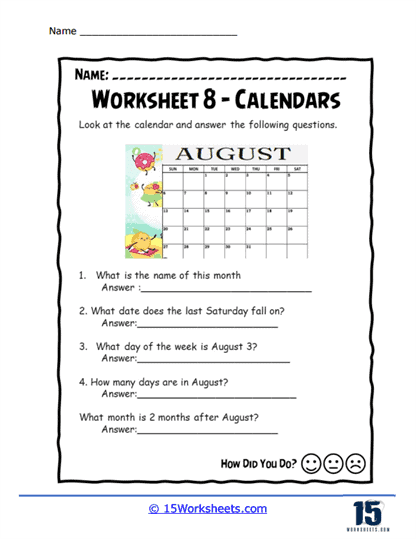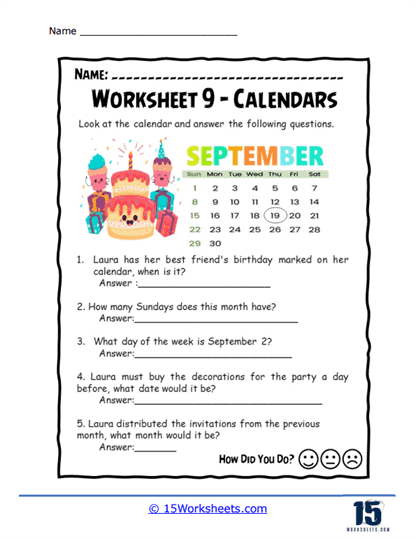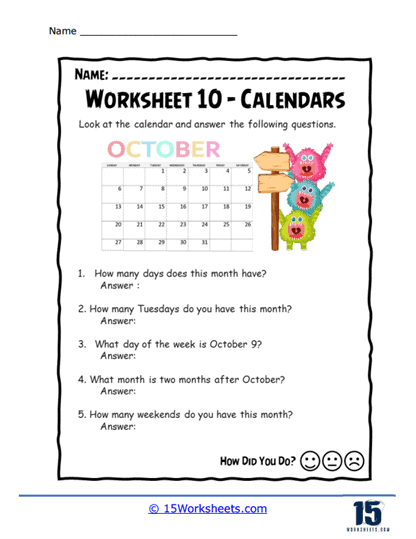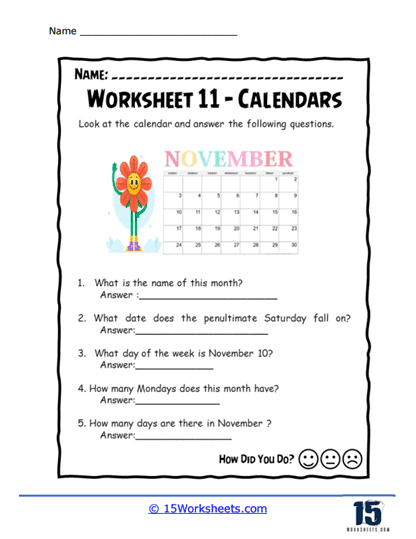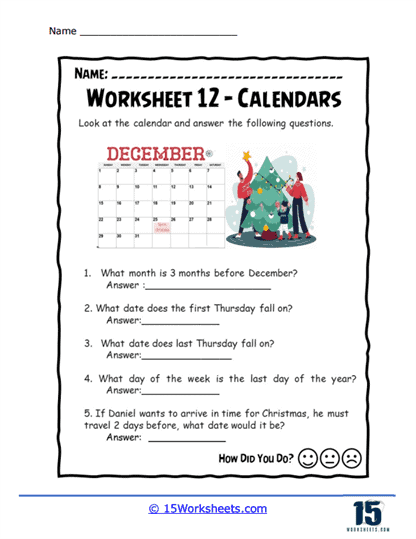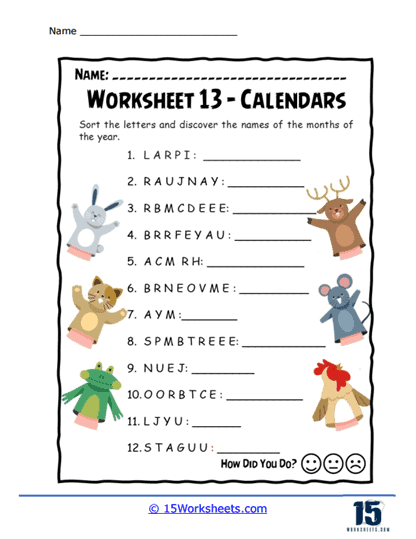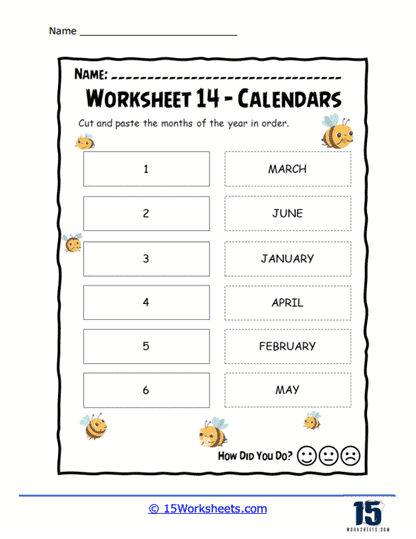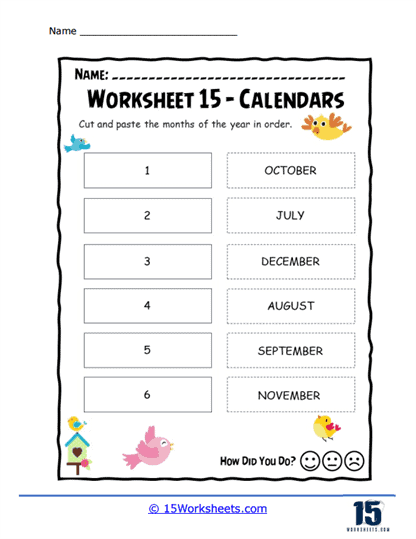Reading Calendars Worksheets
About These 15 Worksheets
These worksheets are used to teach students various mathematical concepts through the practical application of calendars. These worksheets incorporate real-world scenarios, allowing students to develop essential math skills while understanding the functions and uses of a calendar. By engaging with these worksheets, students enhance their ability to read, interpret, and utilize calendars, which are vital skills in both academic settings and everyday life.
Math Skills Explored
These worksheets are designed to test and enhance a variety of mathematical skills, primarily focusing on practical applications of dates and time. One of the fundamental skills examined is the ability to read and interpret a calendar accurately. This involves recognizing and understanding the layout of a calendar, such as identifying months, weeks, and days. Students must be able to locate specific dates, understand the progression of days, and comprehend the cyclic nature of weeks and months.
Another key mathematical skill tested is the ability to perform calculations involving dates. This includes determining the number of days between two dates, which requires an understanding of both arithmetic and the structure of the calendar. Students might need to add or subtract days, weeks, or months to find future or past dates. This aspect of the worksheets helps in building an understanding of elapsed time and reinforces arithmetic skills such as addition and subtraction within a contextual framework.
These worksheets include problems that require interpreting and calculating durations. For instance, students might be asked to determine how long an event lasts if given start and end dates, or to calculate the duration of time between recurring events. This involves understanding units of time, such as days, weeks, and months, and converting between these units when necessary. These skills are crucial for developing time management and planning abilities.
Advanced worksheets incorporate problems that involve understanding holidays and significant dates, requiring students to recognize patterns and use logical reasoning. For example, determining the dates of specific holidays or identifying the day of the week for a given date involves recognizing patterns within the calendar and applying logical thinking. This can extend to understanding and calculating leap years, which introduces concepts related to the Gregorian calendar and the additional day in February.
Exercises on These Worksheets
They feature a variety of problem types and exercises designed to develop a range of skills related to understanding and using calendars. One common type of problem involves date identification. These exercises ask students to locate and circle specific dates on a calendar, such as holidays, birthdays, or significant historical events. This task helps students become familiar with the layout of a calendar and how to quickly find information.
Students work on calculating the number of days between two dates. Students might be given a start date and an end date and asked to determine how many days have passed between them. This type of problem reinforces arithmetic skills, as students must perform subtraction to find the difference between dates. It also helps students understand the concept of elapsed time and how to measure it using a calendar.
These worksheets include problems that involve adding or subtracting days, weeks, or months to find future or past dates. For example, students might be asked to find the date that is 10 days after a given date or three weeks before a specific event. These exercises require students to understand how to navigate the calendar and use arithmetic operations to calculate dates accurately.
Duration calculation exercises are also common on these worksheets. Students might be given the start and end dates of an event and asked to calculate the duration in days, weeks, or months. This helps them practice converting between different units of time and strengthens their ability to work with intervals and periods. For example, they might need to determine how many weeks a school term lasts or how many days are left until a holiday.
The Benefits Of These Worksheets
Learning how to read a calendar and understanding different types of calendars offers numerous benefits, both in educational contexts and in everyday life. One of the primary advantages is the development of time management skills. By becoming proficient in reading calendars, individuals can plan and organize their activities effectively. This skill helps students allocate their study time, schedule extracurricular activities, and meet deadlines. For adults, it is crucial for balancing work commitments, personal appointments, and family responsibilities. Knowing how to interpret a calendar ensures that tasks are completed on time and that one’s daily, weekly, and monthly schedules are managed efficiently.
Real World Application Of This Skill
In the real world, the ability to read and use a calendar is indispensable across various scenarios. For instance, in the workplace, employees use calendars to schedule meetings, set project timelines, and track progress. Accurate calendar reading ensures that deadlines are met and that there is effective coordination among team members. In education, teachers and students rely on academic calendars to plan lessons, prepare for exams, and organize school events. This skill is critical for maintaining academic discipline and achieving educational goals.
Reading calendars is essential for personal life management. Individuals use calendars to remember important dates such as birthdays, anniversaries, and medical appointments. This helps in nurturing personal relationships and maintaining health routines. Calendars also play a crucial role in travel planning. Understanding how to read and calculate dates allows for the effective scheduling of flights, accommodation, and itineraries, ensuring a smooth travel experience.
In addition to these practical applications, calendars are used in various fields such as agriculture, where farmers rely on planting and harvesting schedules dictated by specific dates and seasons. In retail, businesses use calendars to plan sales events, inventory restocking, and marketing campaigns. Even in technology, understanding calendar algorithms is necessary for developing software applications that manage dates and times.


